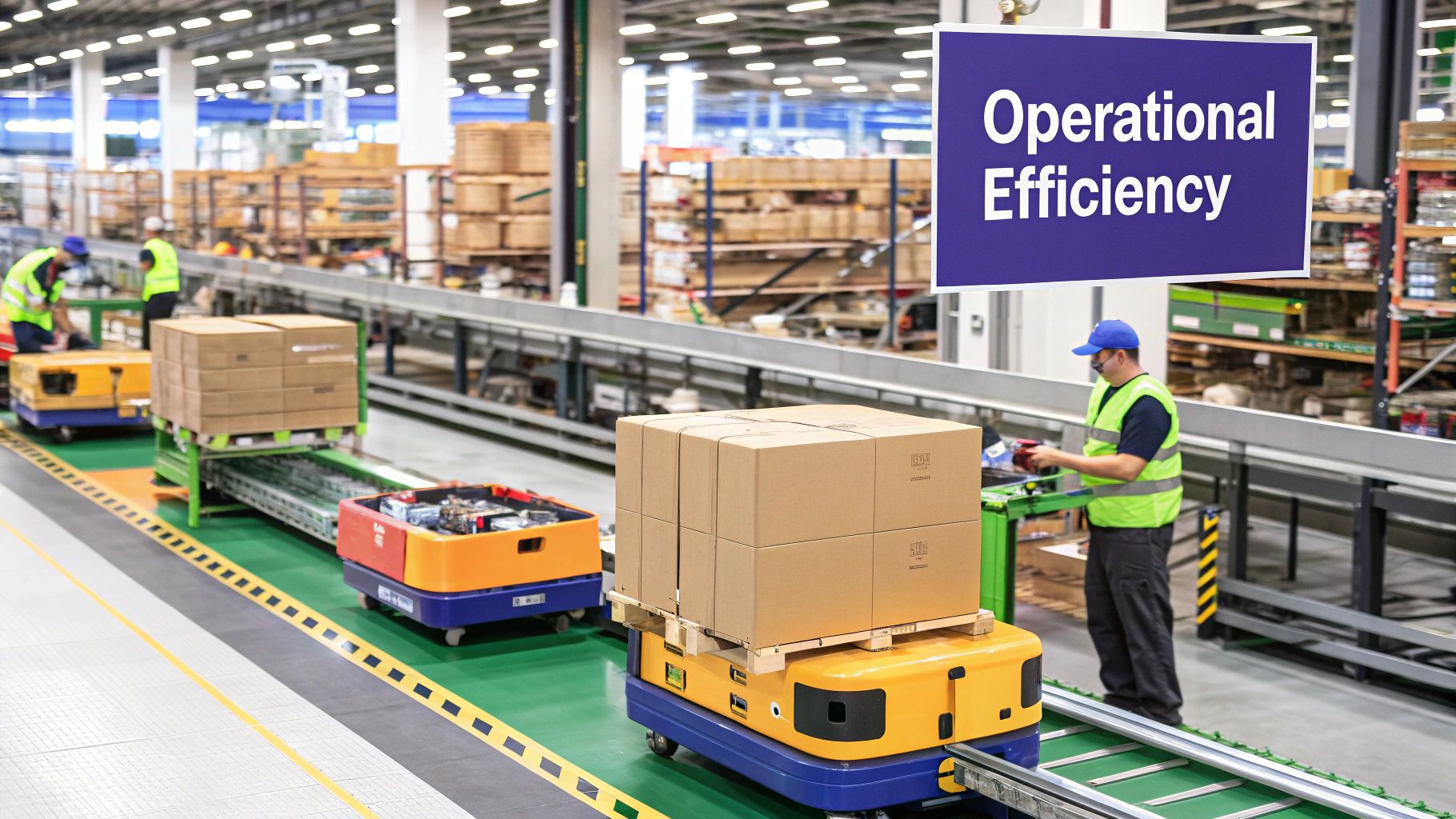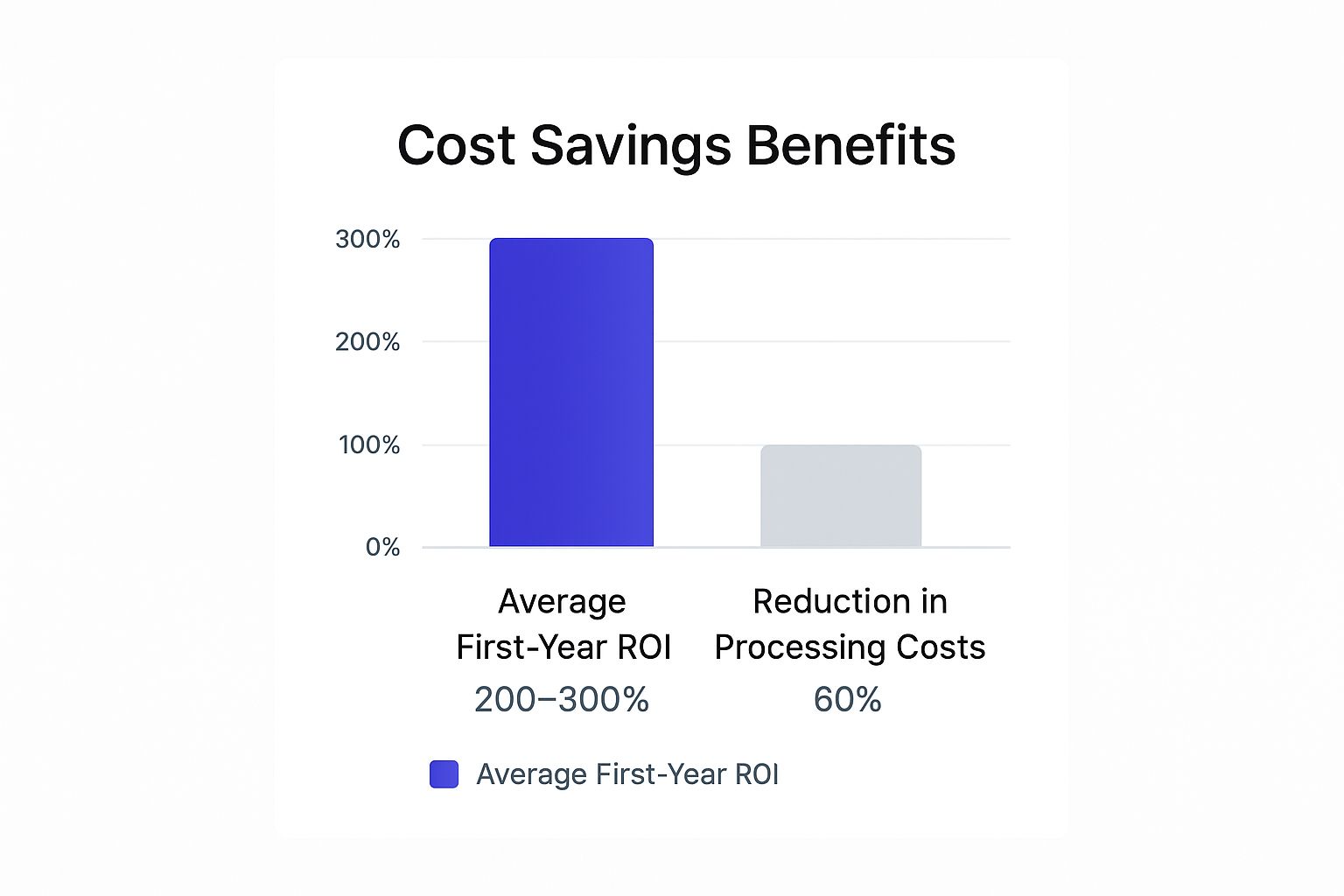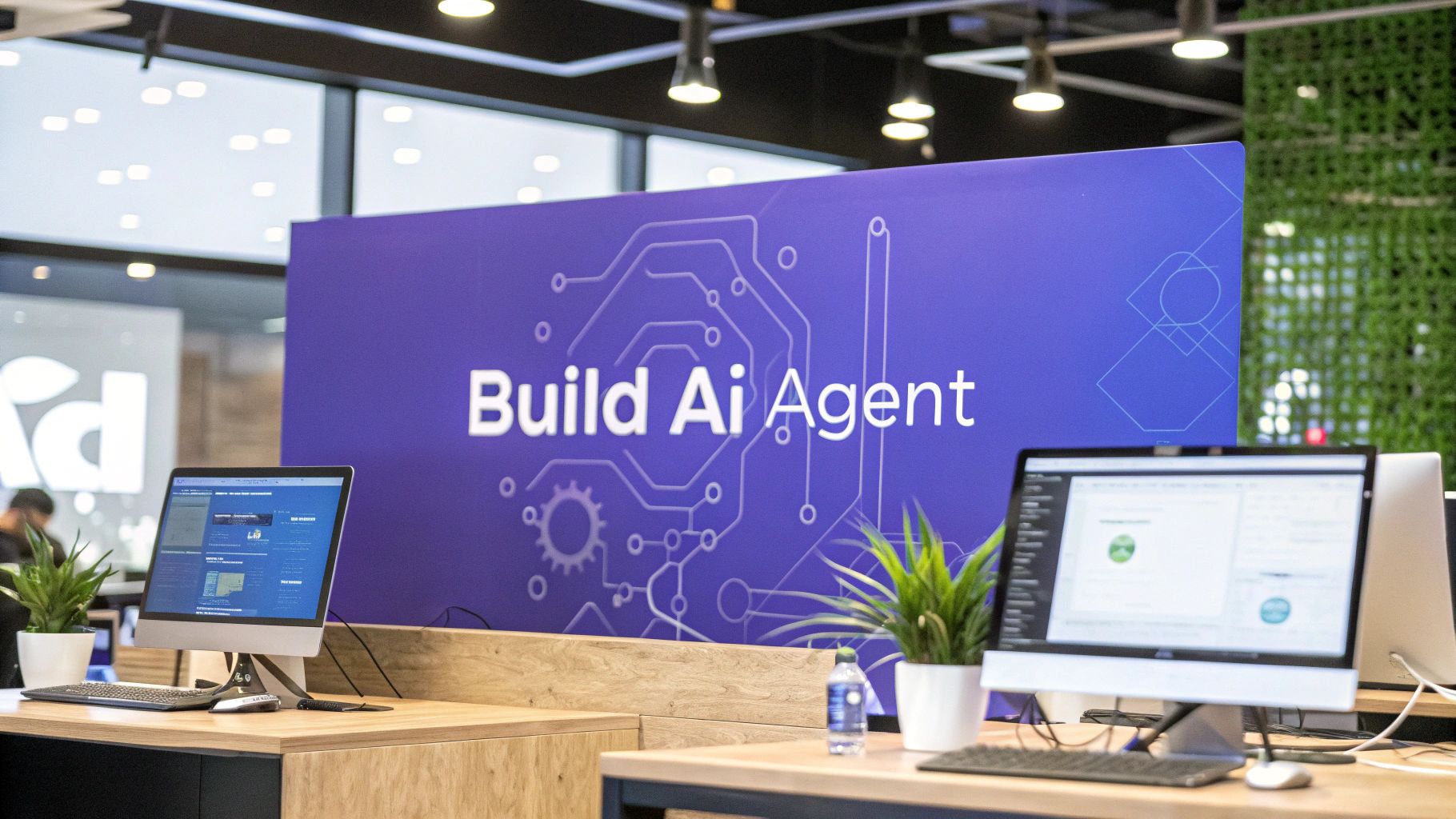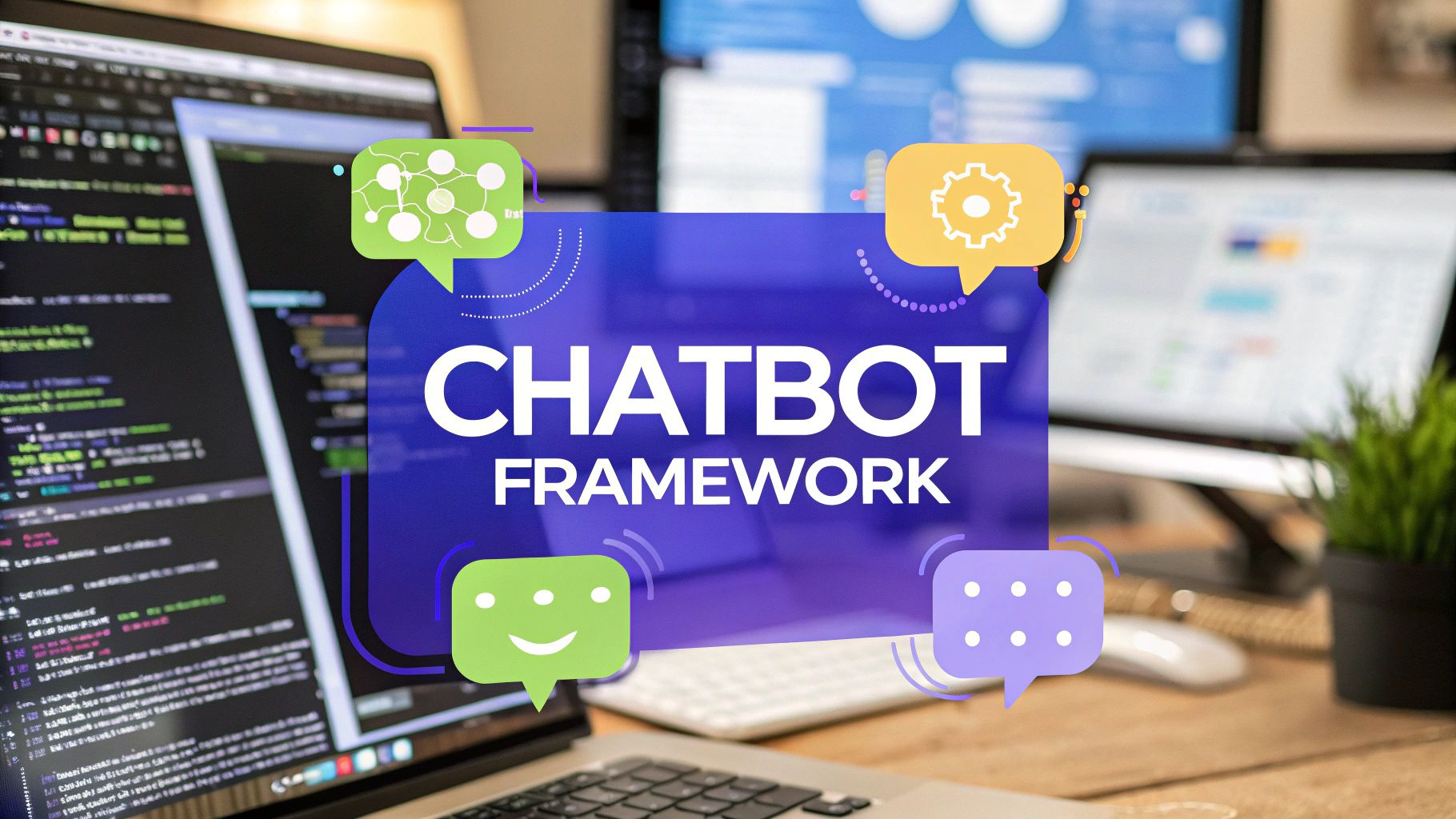8 Key Workflow Automation Benefits for Your Business in 2025
Discover the top workflow automation benefits that can boost efficiency, cut costs, and improve satisfaction. See how AI agents can transform your operations.

In today's competitive landscape, businesses are constantly seeking ways to enhance productivity, reduce operational friction, and scale effectively. The term 'workflow automation' is often mentioned, but what does it truly mean for your bottom line and your team's daily experience? It's not just about replacing manual tasks; it's a strategic imperative for unlocking new levels of efficiency, accuracy, and innovation.
This article moves past the abstract promises to detail the tangible workflow automation benefits your organization can achieve. We will explore eight critical advantages, providing concrete metrics, real-world scenarios, and actionable steps. You will learn how to:
- Boost operational efficiency and reduce costly errors.
- Improve employee and customer satisfaction simultaneously.
- Scale your operations without a proportional increase in headcount.
Crucially, we'll demonstrate how you can leverage these benefits using Chatiant's AI agents to transform core processes, from customer support to internal operations. Our goal is to turn automation from a concept into a powerful, measurable growth engine for your entire business.
1. Increased Operational Efficiency
At its core, one of the most significant workflow automation benefits is the dramatic increase in operational efficiency. It achieves this by taking over routine, repetitive tasks that traditionally consume valuable employee time. By eliminating manual steps and minimizing human intervention in predictable processes, organizations can accelerate task completion, break down operational bottlenecks, and allocate resources more strategically.
This boost in efficiency directly translates to freeing up your skilled workforce. Instead of being bogged down by data entry or standard email responses, employees can dedicate their cognitive energy to high-value activities that demand creativity, critical thinking, and complex problem-solving. It's a fundamental shift from manual labor to strategic oversight.

Real-World Impact and Implementation
The concept of leveraging systems for efficiency isn't new; it has roots in frameworks like the Toyota Production System. Modern pioneers like UiPath and Automation Anywhere have brought this power to the digital realm. For instance, Deutsche Bank utilized UiPath to automate over 500 processes, reclaiming an estimated 1.25 million work hours annually. This allowed them to reallocate talent to more critical banking functions.
With Chatiant, this level of efficiency is accessible and customizable. You can design and deploy an AI agent to handle tasks like:
- Customer Data Lookup: Instantly retrieve customer history or order status from your CRM.
- Appointment Scheduling: Manage calendars and book meetings without manual back-and-forth.
- Internal Helpdesk: Answer common IT or HR questions directly within Slack or Google Chat.
How to Get Started
To effectively harness this benefit, a structured approach is key. Don't try to automate everything at once.
- Start Small: Identify simple, high-volume processes like lead qualification or invoice processing. These offer quick wins and demonstrate value.
- Map Everything: Before automating, thoroughly document the current workflow. This reveals inefficiencies and ensures the automated process is optimized.
- Measure Success: Set clear Key Performance Indicators (KPIs) such as "time to resolution" or "tasks completed per hour" to quantify the efficiency gains.
By implementing automation strategically, you don't just speed up old processes; you create a more agile and productive operational foundation. For a deeper dive into process improvement, you can explore how to optimize your workflow on chatiant.com.
2. Enhanced Accuracy and Error Reduction
Beyond speed, another of the most critical workflow automation benefits is the significant reduction of human error. Manual processes, especially those involving data entry or complex calculations, are inherently susceptible to mistakes. Automation enforces consistency by executing tasks according to pre-defined rules, eliminating the oversights, typos, and misinterpretations that can compromise data integrity.
This enhancement in accuracy is not just about avoiding minor inconveniences; it's about building institutional reliability. By standardizing how processes are performed, organizations ensure that every output is consistent and correct. This is particularly vital in finance, healthcare, and manufacturing, where a single error can lead to substantial financial loss, compliance penalties, or even safety risks.
Real-World Impact and Implementation
The principle of error-proofing processes has been championed for decades by methodologies like Six Sigma. Modern automation platforms, pioneered by companies like Blue Prism, bring this precision to digital workflows. For example, JP Morgan's COIN program reviewed commercial loan agreements in seconds, reportedly reducing loan-servicing errors by 85%. Similarly, Siemens achieved a 99.5% accuracy rate in invoice processing by automating the workflow.
With Chatiant, achieving this level of precision is straightforward. You can configure an AI agent to perform tasks with unwavering accuracy, such as:
- Data Validation: Automatically cross-reference new entries against existing databases to flag inconsistencies.
- Financial Calculations: Execute complex calculations for quotes or reports without manual input errors.
- Order Processing: Ensure every customer order is entered into your system with the correct items, pricing, and shipping details.
How to Get Started
To maximize accuracy gains, your implementation needs to be meticulous and well-planned.
- Implement Validation: Build multiple checkpoints into your automated workflow where data is verified against established rules or external sources.
- Test Rigorously: Before full deployment, create comprehensive test scenarios that cover both common use cases and edge cases to ensure the automation behaves as expected.
- Plan for Exceptions: Establish a clear, automated procedure for handling exceptions or tasks that fall outside the defined rules, escalating them to a human for review.
By focusing on accuracy, you create a system of record that your entire organization can trust. This builds a foundation for better decision-making and operational excellence. For more on this, you can learn how to automate data entry tasks on chatiant.com.
3. Significant Cost Savings
Beyond operational improvements, one of the most compelling workflow automation benefits is the direct and substantial impact on your bottom line. Automation achieves significant cost savings by reducing reliance on manual labor for repetitive tasks, minimizing the frequency of expensive human errors, and optimizing how resources are allocated across the organization. This isn't just about trimming minor expenses; it's about fundamentally lowering the cost to operate.
By automating rule-based processes, companies can drastically cut down on labor costs and operational overhead. This financial advantage often compounds, as automated systems can scale to handle increased volume without a proportional increase in costs. Research from firms like McKinsey & Company consistently shows that organizations see a significant return on investment, often within the first 6 to 18 months, as savings from reclaimed hours and error prevention accumulate.
This bar chart highlights two key metrics that illustrate the powerful financial impact of automation.

The visualization clearly shows how automation not only pays for itself but generates substantial returns while slashing process-specific expenses.
Real-World Impact and Implementation
The financial gains from automation are well-documented across industries. For example, American Express was able to reduce its customer service processing costs by an incredible 60% by implementing automated workflows. Similarly, global shipping giant Maersk saved an estimated $50 million annually by automating its complex shipping documentation processes, a testament to the power of automation at scale, a concept often discussed by leaders like ServiceNow's Bill McDermott.
With Chatiant, achieving this level of cost reduction is straightforward. You can build AI agents to target high-cost areas, such as:
- Automated Invoice Processing: Reduce manual data entry and prevent costly payment errors.
- Supply Chain Management: Automate order placements and inventory tracking to optimize stock levels and reduce waste.
- Customer Refund/Return Processing: Handle standard refund requests automatically, freeing up support agents for complex cases.
How to Get Started
To maximize cost savings, approach automation with a clear financial strategy.
- Target High-ROI Processes: Begin with workflows that are labor-intensive and error-prone, like accounts payable or data reconciliation, to secure quick wins and demonstrate clear ROI.
- Calculate Total Cost of Ownership (TCO): When evaluating platforms, look beyond the initial price. Factor in implementation, maintenance, and potential training costs for a complete financial picture.
- Monitor and Measure: Continuously track key financial metrics. Use KPIs like "cost per transaction" or "reduction in overtime hours" to quantify the savings and justify further investment.
By focusing on the financial benefits, you can build a powerful business case for automation that resonates across all departments. For more on building a business case, check out our guide on calculating automation ROI on chatiant.com.
4. Improved Employee Experience and Job Satisfaction
Beyond pure metrics, a key workflow automation benefit is its profound impact on the human element of your business. Automation liberates employees from the monotonous, repetitive tasks that often lead to burnout and disengagement. By handling the drudgery, it empowers your team to focus on meaningful, creative, and strategic work that requires human ingenuity. This fundamental shift from task-doer to problem-solver directly boosts job satisfaction, engagement, and talent retention.
When employees are no longer bogged down by routine data entry or processing standard requests, they can invest their energy in innovation, building customer relationships, and professional development. This creates a more dynamic and fulfilling work environment where people feel valued for their minds, not just their ability to complete a checklist.

Real-World Impact and Implementation
This focus on employee well-being has been championed by forward-thinking companies like Google, Slack, and Atlassian. For instance, IBM automated many of its routine HR processes, which freed up its HR staff to concentrate on high-impact employee development and talent management programs. Similarly, by automating routine CRM updates, Salesforce found that its sales teams could spend up to 30% more time actively engaging with customers, leading to better results and higher morale.
With Chatiant, you can foster this positive environment by deploying AI agents to absorb the grunt work:
- Automated Reporting: Generate daily or weekly sales and support reports automatically, freeing teams from manual data compilation.
- Lead Nurturing: Handle initial lead follow-ups and qualification questions, so sales reps can focus on high-intent prospects.
- Internal Knowledge Base: Allow an AI agent to answer repetitive policy or procedure questions, reducing interruptions for senior staff.
How to Get Started
To ensure automation enhances the employee experience rather than causing anxiety, a people-first approach is crucial.
- Communicate Clearly: Frame automation as a tool to help employees, not replace them. Highlight how it will free them up for more interesting work.
- Provide Reskilling: Offer training opportunities that equip your team with the skills needed to manage, oversee, and work alongside automated systems.
- Involve Your Team: Ask employees which parts of their jobs are most tedious. Involving them in the automation planning process builds buy-in and ensures you’re solving real pain points.
By strategically automating tasks, you invest in your most valuable asset: your people. This creates a virtuous cycle of higher satisfaction, better performance, and lower turnover.
5. Enhanced Scalability and Growth Capacity
A crucial workflow automation benefit for any ambitious organization is the ability to scale operations without a proportional increase in costs or resources. Automation provides the structural backbone for growth. As your business expands, handling more customers, transactions, or requests, automated systems can manage the increased volume seamlessly. This prevents growth from overwhelming your team or service quality.
This inherent scalability allows your business to accommodate higher demand, whether from sustained growth or seasonal peaks, without needing to frantically hire temporary staff or burn out your existing team. It ensures that your operational capacity expands in lockstep with your opportunities, providing a stable foundation for long-term success.
Real-World Impact and Implementation
The principle of building systems that scale has been famously demonstrated by tech giants. Shopify, for example, relies on automated order processing to handle massive traffic spikes during events like Black Friday, managing surges of over 500% without system failure. Similarly, Amazon Web Services pioneered the concept of elastic, on-demand infrastructure that powers countless scaling businesses.
With Chatiant, you can embed this scalability directly into your core operations. An AI agent can be configured to manage a growing workload, such as:
- Onboarding New Clients: Automatically send welcome packets, schedule kick-off calls, and provision accounts as you sign up more customers.
- Processing Inbound Orders: Handle an increasing volume of e-commerce orders, from confirmation to fulfillment updates, without manual intervention.
- Managing Support Tickets: Instantly categorize and assign an ever-growing number of customer support requests to the correct teams.
How to Get Started
To ensure your automated workflows support future growth, you must build them with scalability in mind from the very beginning.
- Design for Volume: When mapping your workflow, don't just solve for today's volume. Consider how the process would hold up with 10x or 100x the load.
- Use Cloud-Based Platforms: Choose automation tools built on cloud infrastructure, like Chatiant, that offer elastic scaling and can handle demand fluctuations automatically.
- Monitor Performance: Implement monitoring to track key metrics like processing time and error rates under load. This helps you identify and fix potential bottlenecks before they impact customers.
By building scalable workflows, you're not just improving current processes; you're future-proofing your business for the growth you're working hard to achieve. To see how AI agents can help, explore Chatiant's features for business growth.
6. Better Compliance and Audit Readiness
Navigating the complex web of regulatory requirements is a major challenge for modern businesses. One of the most powerful workflow automation benefits is its ability to enforce compliance and simplify audit readiness. By automating processes, organizations create an immutable, digital audit trail where every action is logged, timestamped, and traceable. This eliminates the "he said, she said" of manual processes and provides a clear, objective record for auditors.
This systematic approach ensures that critical compliance checks are embedded directly into your operations and are never skipped due to human error or oversight. Automation enforces adherence to internal policies and external regulations consistently, mitigating the significant risks associated with non-compliance, such as hefty fines, legal action, and reputational damage. It transforms compliance from a periodic, stressful event into a continuous, manageable state.
Real-World Impact and Implementation
The push for automated compliance is championed by global advisory firms and technology providers. Leaders like Deloitte and Thomson Reuters have built extensive practices around this principle. For example, financial institutions like HSBC have leveraged automation for Anti-Money Laundering (AML) workflows, ensuring that every transaction is screened against sanction lists without exception. Similarly, companies in highly regulated sectors, such as Johnson & Johnson with FDA submissions, use automation to guarantee process integrity and documentation accuracy.
With Chatiant, you can embed these critical compliance guardrails directly into your daily operations. An AI agent can be configured to:
- Enforce Approval Chains: Automatically route contracts or expense reports to the correct sequence of approvers based on predefined rules.
- Log User Access: Document every time a team member accesses sensitive customer data within your systems.
- Monitor for Keywords: Flag conversations or documents containing keywords related to GDPR or HIPAA for immediate review.
How to Get Started
Implementing automation for compliance requires a meticulous and proactive approach. Your goal is to build a system that is both robust and adaptable.
- Integrate Compliance Checks: Don't treat compliance as an afterthought. Build validation and approval steps directly into every stage of your automated workflows.
- Document Everything: Maintain thorough documentation not just of the workflow's output, but of the automated process itself. This helps explain your compliance strategy to auditors.
- Stay Current: Regulations change. Set up a process to regularly review and update your automation rules to reflect the latest legal and internal policy requirements.
By automating compliance, you are not just ticking boxes; you are building a resilient operational framework that protects your business from risk and instills confidence in stakeholders and regulators.
7. Accelerated Decision-Making and Response Times
In today's fast-paced markets, the speed of your response can be a decisive competitive advantage. One of the most impactful workflow automation benefits is its ability to radically accelerate decision-making. By processing vast amounts of data, applying predefined business rules, and triggering actions instantly, automation removes the latency inherent in manual review and approval cycles.
This capability transforms how an organization reacts to everything from customer inquiries to market shifts. Instead of waiting hours or days for a human to analyze information and make a routine decision, automated systems can execute the same process in seconds. This ensures that opportunities are captured and issues are resolved before they escalate, maintaining momentum and customer satisfaction.
Real-World Impact and Implementation
The principle of using systems for rapid decision-making has been pioneered by leaders in finance and data analytics, like Goldman Sachs with its algorithmic trading and Palantir with its data integration platforms. For example, Capital One’s automated system can process a complex loan application and deliver a decision in under 60 seconds, a feat impossible with manual underwriting.
With Chatiant, this velocity is now accessible for your core business operations. You can empower an AI agent to make rule-based decisions instantly:
- Lead Scoring and Routing: Automatically analyze new lead data against set criteria and route high-value prospects to senior sales reps in real-time.
- Fraud Detection: Flag suspicious transactions or user activities based on predefined patterns, triggering immediate alerts or account locks.
- Customer Support Triage: Instantly categorize incoming support tickets by urgency and topic, assigning them to the correct team without delay.
How to Get Started
To leverage automation for faster decisions, you need to build a system based on clarity and trust.
- Define Clear Criteria: Document the exact rules and data points your system should use to make a decision. What qualifies a lead? What constitutes a high-priority ticket?
- Establish Escalation Paths: For decisions that fall outside the predefined rules or meet a certain complexity threshold, create a clear path for human review.
- Monitor and Refine: Continuously track the outcomes of automated decisions. Use this data to refine your rules and improve the system's accuracy over time.
By automating routine decisions, you empower your team to focus on strategic exceptions and complex challenges, creating a more responsive and intelligent organization. To see how AI can streamline your operational choices, you can learn more about AI-driven automation on chatiant.com.
8. Enhanced Customer Experience and Service Quality
Another of the most impactful workflow automation benefits is the ability to drastically improve the customer experience and overall service quality. Automation ensures consistency, reduces response times, and provides 24/7 availability for support. By instantly acknowledging customer requests, intelligently routing tickets, and providing real-time status updates, businesses can deliver a seamless and reliable service journey.
This consistency builds trust and loyalty. When customers know they can get immediate, accurate information or resolutions any time of day, it elevates their perception of your brand. It moves your service model from reactive and capacity-constrained to proactive and always-on, directly boosting customer satisfaction and retention.

Real-World Impact and Implementation
This principle has been mastered by customer-centric leaders like Amazon and Zendesk. For example, FedEx's automated package tracking system empowers millions of customers with real-time updates without human intervention. Similarly, Airbnb’s automated booking and communication workflows provide instant confirmations and vital information, creating a smooth and trustworthy user experience.
With Chatiant, you can build an AI agent that delivers this level of service excellence by:
- Providing Instant Answers: Offer 24/7 support by answering common questions about products, policies, or order status.
- Routing Inquiries: Automatically analyze a support ticket's content and route it to the correct department or agent.
- Proactive Updates: Send automated notifications about order shipments, service appointments, or account changes.
How to Get Started
Implementing automation in customer service requires a delicate balance to enhance, not replace, the human element.
- Automate the Routine: Focus on high-volume, low-complexity queries first. This includes "Where is my order?" or "What are your business hours?".
- Ensure Easy Escalation: Always provide a clear, simple path for a customer to connect with a human agent if the automation cannot resolve their issue.
- Personalize Communications: Use customer data to personalize automated responses. A simple "Hi [Customer Name]" can make a significant difference.
By carefully integrating automation, you can free up your support team to handle complex, high-empathy issues, thereby improving both efficiency and service quality. You can explore how to get started with customer support automation on chatiant.com.
Workflow Automation Benefits Comparison
Your Next Step: From Plan to Automated Action
Throughout this article, we've explored the transformative power of workflow automation. We've moved beyond abstract concepts to detail tangible outcomes, showing how strategic automation drives success across every facet of an organization. From boosting operational efficiency and slashing costs to enhancing employee morale and elevating the customer experience, the workflow automation benefits are clear, compelling, and cumulative. Each automated task builds upon the last, creating a powerful engine for growth and innovation.
The journey we have charted covers a broad spectrum of advantages. We have seen how automation drastically reduces human error, ensuring higher accuracy in critical processes. We have detailed how it creates significant cost savings by optimizing resource allocation and minimizing manual labor. Furthermore, we've highlighted its role in fostering better compliance and simplifying audit readiness, a crucial element in today's regulated landscape. These are not isolated perks; they are interconnected pillars supporting a more resilient and agile business structure.
From Insight to Implementation
The most critical takeaway is that these benefits are not reserved for massive corporations with unlimited budgets. They are accessible to any team, in any department, that is ready to take a strategic first step. The key is to shift your mindset from viewing automation as a complex, monolithic project to seeing it as a series of small, high-impact improvements.
Where do you begin? Start by identifying a single, persistent bottleneck.
- For Sales Teams: Is it the manual entry of lead data into your CRM?
- For Operations: Is it the constant back-and-forth required to approve a request?
- For Customer Success: Is it the time spent answering the same handful of questions every day?
By isolating a specific pain point, you create a focused, manageable starting point for your automation journey. This initial success will not only deliver immediate value but also build the momentum and confidence needed to tackle more complex workflows. This targeted approach ensures that your initial investment of time and resources yields a demonstrable return, making the case for wider adoption.
The True Value: Empowering Your People
Ultimately, the most profound of all workflow automation benefits is the empowerment of your team. By removing the burden of repetitive, low-value tasks, you unlock your employees' true potential. You free them to focus on strategic thinking, creative problem-solving, and building meaningful customer relationships. This is where real competitive advantage is born.
When your team is engaged, motivated, and equipped with tools that eliminate friction, they become proactive drivers of success. An automated system doesn't just complete tasks; it creates an environment where human ingenuity can flourish. This cultural shift, from reactive task management to proactive value creation, is the ultimate goal and the most sustainable benefit of a well-executed automation strategy. The future of work is not about replacing people, but about augmenting their capabilities to achieve extraordinary results.
Ready to unlock these workflow automation benefits for your own team? Discover how Chatiant can help you build and deploy intelligent AI agents in minutes, automating everything from customer support on your website to internal processes in Google Chat. Start your journey toward a more efficient and empowered workplace today by exploring Chatiant.


